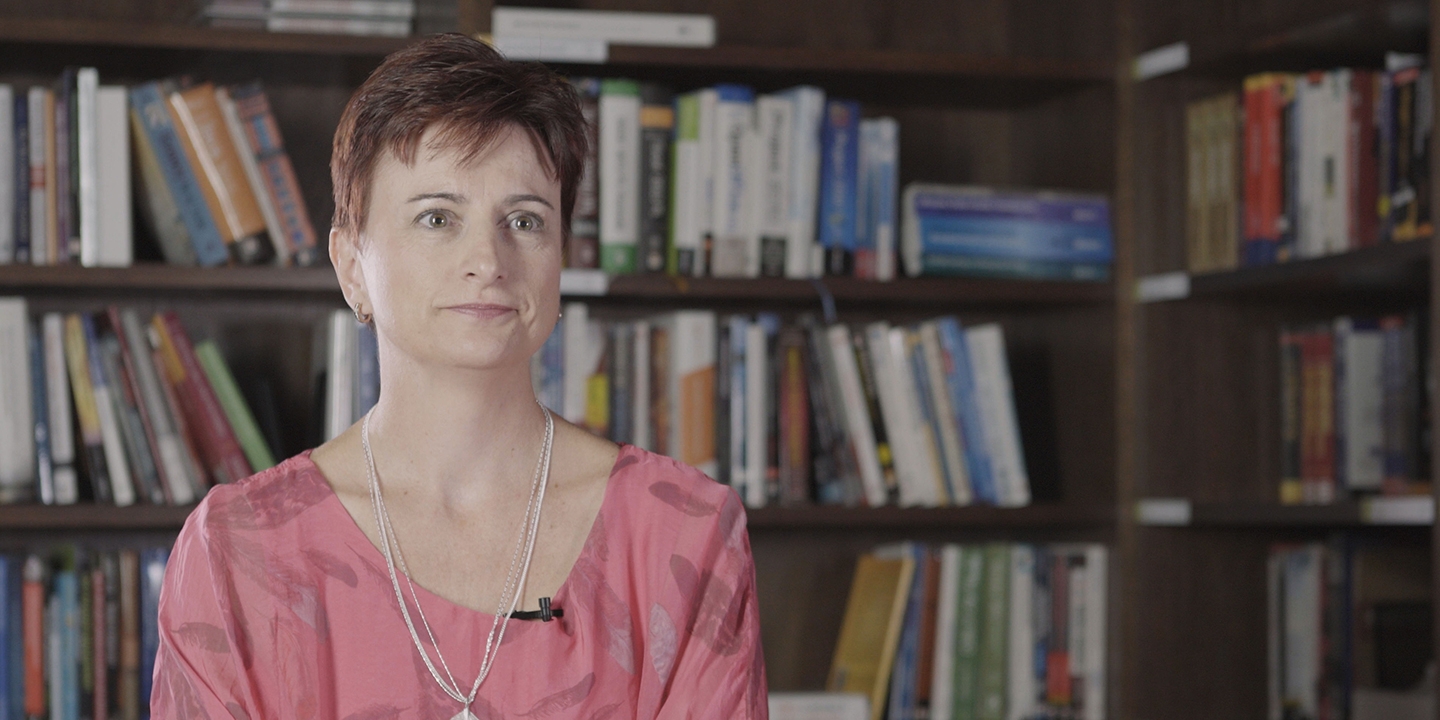- Insights hub
- /
- How NOT to do B2B Marketi...

How NOT to do B2B Marketing in the IT industry – challenges and takeaways with Russ Powell
- DetailsAbout the talks
- TranscriptTranscript
How NOT to do B2B Marketing in the IT industry – challenges and takeaways with Russ Powell
Michał Grela
Relationship Manager at Future Processing
B2B marketing is a tough nut to crack, especially during the pandemics where we all had to change our ways of work to certain extent. One of many examples comes from my own experience – being part of the Field Marketing department and focusing, among others, on exploring business relationships at different events, COVID-19 turned it all upside down and we had to look for other possibilities enabling us to build long-lasting partnerships, rather than flying over the world and meeting people face to face.
However, with or without pandemics, when it comes to B2B Marketing in the IT industry the competition is fierce and the companies keep on coming up with more and more unique solutions how to attract potential customers.
Some of them focus mostly on the short-term actions, which are great in generating business here and now, some invest also in the brand building which additionally offers long-term benefits and translates to business growth in the future. Finding the balance between the two approaches seems like a way to go, but it’s not an easy task for the Marketing department.
My guest is Russ Powell, who has a very interesting story to share.
Michał Grela (MG): Hello, and welcome to another episode of IT Insights by Future Processing. Today We’re going to discuss how not to do B2B marketing in the It industry. B2B marketing in general is a tough nut to crack for sure, especially during the pandemic where we all had to change our ways of work to certain extent. One of the many examples come from my own experience, since I was focusing among others on exploring relationships with different events, and of course COVID turned it all upside down and had to look for other possibilities, enabling us to shake hands rather than flying over the world and meeting people face to face sadly, however, with or without pandemics, when it comes to B2B marketing in the IT industry, the competition obviously is fierce and the companies do whatever they can to come up with more and more unique solutions, how to attract potential customers.
It’s very easy to fall into the trap of buzzwords and to do it all wrong, likely with experts such as my guest today, all dancing and all shiny marketing is at your fingertips. Today my guest is Russ Powell, who has a very interesting story to share. So Russ, could you please tell us more about yourself, your company, how it all started, stage is yours.
Russ Powell (RP): Yeah. I love the term all dance and all shine in marketing as well.
MG: I copied it from one of your articles, I believe.
RP: Good stuff. So, yeah. Hi, I’m Russell I’m founder, MD of a marketing agency called Shaper B2B Marketing. So we actually launched April, 2020 so right in the midst of the first pandemic, the first lockdown over here in the UK. And that was actually a direct result of redundancy on my part. So I was working client side, was made redundant at the end of February, and then via the power of LinkedIn, was connected to a chap who is now… Or he was, still is a group CEO of Selbey Anderson group who are our parent company, was given the opportunity to launch Sharper. And really the idea for Sharper had formulated in my mind a couple of years before, and was just given the opportunity to bring it to life. And the idea for Sharper really came from the frustrations that I felt as a client side marketer. So I’ve spent 12 plus years on the client side in B2B tech, II organizations of varying shapes and sizes, and Sharper is really set up and launched with the aim of tackling those major frustrations that I felt as a client side marketer, because one of the things we like to say is that we’re built in the agency that we would like to work with if we were still working client side.
MG: So in your case, the pandemic was an accelerator for change. It’s good to hear that, at least some good happened because of the virus. You’ve mentioned frustrations so, let that be the first issue to discuss basing on your experience, could you name some top frustrations and pains in terms of B2B marketing with the client side?
RP: Yeah, well I think the three main frustrations I felt on the client side directly translated into our mission as an agency, which is to make B2B markets as a whole more creative, more valued and more commercially successful. And it’s really that creativity, value and commercial success were the three big frustrations I felt client side. The creative side of things is that in B2B tech, largely everyone’s got a blue logo, everyone uses the same stock imagery, everyone talks about the same hyper-converged, ultra optimized platforms and solutions, doesn’t mean anything to people. And it’s… There are still people making these decisions, it may be business to business, but there are people that are emotional and irrational and have different wants and needs. And you need to appeal to people as people, not as business bots, who aren’t thinking and aren’t feeling about things. So that’s the creativity side of things. The value side of things is, working in large IT organizations, marketing often gets referred to as just the coloring in department. So it’s the team that the sales guys go to when they need a PowerPoint deck.
MG: … or a gift to a customer.
RP: They need branded merch for an event and all that kind of stuff. Marketing can and should add so much more value for their business and marketers don’t or marketing doesn’t, because sometimes they don’t understand or appreciate that value that they can add, and tied to that is the commercial success side things. So it’s my belief that marketing and marketers absolutely have a commercial responsibility to their business. Everything marketing does should in some way or other add a positive commercial effect to the business. And I appreciate that may be stronger for some tactical activities, but it may be looser for some others, but there needs to be able to demonstrate that what you do adds value for your business, and that value can translate into revenue on the bottom line.
MG: Yeah, definitely. This frustrations are present. I too used to work in places where marketing was just a go-to place for merch. And this human to human aspect is definitely missing in plenty of campaigns and the way you put it, I completely agree that most of the B2B IT companies are just very much similar, very much the same when it comes to the way they look from the outside of this.
RP: I would even say that human to human is potentially a wrong way to frame it as well, because human is our species, and I think if you were to ask somebody to describe themselves, they wouldn’t describe themselves as a human. You’d describe yourself… I’d describe myself as Russ, you’d describe yourself as Michal, you’re a person, you have different foibles and different ways of doing things and different ways of thinking, so the catch-all term of human is too broad, it’s about people.
MG: Yeah. Interesting takeaway. You mentioned that the last frustration is about the lack of the commercial awareness, let’s put it that way and that you stated that marketing could and should, if not has to, affect the bottom line. So how do you, track the performance when it comes to affecting the bottom line, what are the key metrics, best practices?
RP: The key metric is revenue. That’s the one metric that everyone in every business cares about. And so, as marketing functions, as marketers, we need to demonstrate how we impact revenue, how we add revenue, either directly through bottom of the funnel conversion activity that generates leads and opportunities, or whether it’s about growing and building awareness with the right audience, whether it’s about how content is read and perceived and how that adds a knock-on effect in terms of building momentum for a brand as well. And like I said before, it is tricky, it’s tricky for marketers because a lot of what we do, doesn’t directly tie to revenue, it has a knock-on effect down the line. So we need to find ways of talking about marketing in a business way.
I wrote a blog on this recently that as marketers, we have a lot of KPIs that we track. We look at different performance across different channels. We have loads of different ways that we can measure success. But when we’re let out into the business to talk to non-marketers about marketing, we slip back in to talking about these KPIs and these stats and these measures that a salesperson or a finance director is going to go “So what?” And it’s about saying… It’s about making what we do as marketers, as realistic and as real as possible for the rest of the business. So it’s not about throwing away your KPIs and binning in them off, it’s about talking about them in a way that makes them relevant to the other people in your business who will then have a better perception of marketing, and more clearly understand the value that marketing adds.
So rather than saying “Oh, we’ve increased traffic to the website by this percentage and dwell time’s up by this amount, and we’ve gotten so many sessions and page views.” And all that kind of stuff, which a sales guy’s not going to really care about. But what you can say is “Look, we ran campaigns into this audience, we know that we delivered this, the people landed on our site, looked at this content, they went on this journey, so they looked at these things and they’ve then come out of the bottom end, expressing interest in having a conversation.” So we can as marketers take what we know in terms of the KPIs and what we deliver and all the great things that we get excited about, but make them much more relevant for the business and much more useful for the rest of the business as well.
MG: Yeah. I completely agree that this stakeholder buy-in is one of the biggest challenges for some marketers. So it’s really important to convince the people that are not only signing off your budgets, but to actually have them on board, and that’s really important. Could you share some tips on how would you deliver that? How would you take them on board? How to actually achieve this buy-in of stakeholders? The first you mentioned is speaking their language, is there anything else you should focus on?
RP: So I think it’s about listening as well because some people and some senior leaders don’t get marketing, they don’t understand marketing. They think that marketing is comms, or they think that marketing is advertising, when obviously it’s a whole multitude of different disciplines that all combine to drive things forward. And I think sometimes there’s a case for even looking at the attitudes that people have across the business and saying “Can I convince this person? Or is the fight going to be too much? Are they so far gone that they will never believe that marketing can add the value that it can?” And you can often… You see this a lot in sales driven organizations, where it’s very much quarter to quarter, you’ve got to hit numbers and there is an imbalance in terms of the short-term sales activation and long-term brand building that can happen because numbers need to be hit right here right now. So the business is always going to prioritize those short term activities that will generate leads, get demos done, and get invoices signed.
Whereas we know as marketers and it’s been proven time and time again in research, Binet And Field, The Long and Short of It, all that kind of stuff that you need to balance, The long and the short term, but if you’re in a business that is so self-driven focused on those right here, right now numbers, are you potentially going to have too bigger a fight that you’re never really going to win to try and convince the business that marketing can, and should be done in a different way to deliver value over the long term? And there are ways you can do that, it can be a struggle and you can use… You can look at the research, you can use stats, you can appeal to people’s ego and the emotional side of the things as well.
One of the best arguments I’ve always found for looking at a more whole approach to marketing is that there’s research done that says that, I think it’s between only three to 5% of a market are in a buying window at any one time. So if you focus exclusively on trying to find those three to 5% of people all the time, you completely alienate the other 95 to 97% of people who aren’t in market right now, but who will be in a buying circle, in a buying window at some point in the future. And it’s kind of the argument, would you rather have a handful of quick deals right now, or would you rather have a whole load of big deals for the next few years? And there’s often a balancing act to be done there, especially in terms of convincing senior leadership that marketing needs to be approached in this long and short way.
MG: I’d love having both, if that’s even doable. And I think that reasonable, sound marketing department should strike this balance and try to have this both solid legs. One that would focus around this short term six months, let’s say horizon on who’s on the market right here, right now. But this brand activation, long-term campaigns that are even targeted broader than your ICP will bring you revenue in a year’s time. But, this time will fly anyway. So after a year you can either be in a place where you enjoy the results or are still off what you did a year before, or are still only focusing on right here, right now. So it’s a very-
RP: Yeah, the research has been done, it’s been proven time and time again with actual facts and figures and numbers, that short term sales activation will get you a peak in sales but it quickly tails off. Long-term brand building will generate growth over time. And like you say, if you can marry the two, you have those peaks that then level off, but you also grow over time as well. So it’s not about, like you said, it’s not about doing one or the other, it’s about the balance of the two over a long period of time.
MG: The other challenge I also very often come across when it comes to marketing in the IT industry, is the expectations versus reality aspect. So even implementing all the best practices in the marketing structures and processes and all that sort of good stuff in an IT company, I still sometimes don’t feel that it’s tangible when it comes to, what should I expect as an outcome? Is there a limit to expectations or should you aim high for the beginning? I know there are some activities that take years to bring ROI. Some of them are really short term, how do you set a limit to expectations?
RP: I think the key thing here is not expecting the same thing from every activity. So you can’t measure everything marketing does in exactly the same way, you wouldn’t measure the effectiveness of a PPC campaign, the same way you would an ABM campaign for example, because PPC is right here, right now, you’re focused on cost per click, you’re focused on something else and you can see that right here, right now. But if you try and measure an ABM campaign in the same way, you would a PPC campaign, you’re going to get disappointed. But equally, if you try and measure a PPC campaign, looking at penetration into an account, how many people you know, the conversations that were going on, you’re again, going to be disappointed because it’s not going to deliver that. So I think it’s very much about being, being mindful of the channel mix you’re using and not measuring everything exactly the same and knowing how to juggle and mix the channels that you use to engage the audience you need to engage.
And I think this is often… Often something that we find is that people go from “Right, we need to do this.” And then they jumped straight to the tactic like “Oh, we need to grow sales by this amount, this year.” It’s like “Okay, cool. Let’s do some LinkedIn campaigns.” And you’re like “Well, hold on. How do you know that the buyers you need to target are even active on LinkedIn? How do you know that, that’s where the message is going to get across and people are going to engage?” And there was a great quote, I don’t know if you’ve subscribed to the Harry Dry, Marketing Examples newsletter, it’s fantastic. It’s one of the few email newsletters that I actually read when it comes into my inbox, but he had a great quote in there it was “With marketing, you need to fish where the fish are.”
And that’s about being realistic and measured in terms of the actual tactics that you use to get messages to the right people. And yeah, people think they need to do a thing and they jump straight to tactics, they miss out all the important stuff that needs to be done in the background, which is “Okay, this is what you need to do, but who is that ideal customer? What’s the type of work? What’s the sector? What’s the organization? And most importantly, who’s the person that you need to engage with? What’s their role? How do they think about things? Who else they connected to in their business?” And then how do you use all of that to create messages, position in the propositions that effectively talk about and deal with the challenges and needs that these people have.
And then when you’ve worked all of that out, you then look at the channels you use to get those messages in front of the right people. So you got to go from the “What are we doing?” You’ve learned to do the who bit, you’ve got to do the “What are we going to say? And then you do the how bit rather than going “Well here’s what we need to do.” And you jump in straight to how. You got to do the build exercise in the background to make marketing more valuable, more rounded, more able to deliver what the business needs it to.
MG: I couldn’t agree with you more and thank you for the tape. I already signed up for the Marketing Examples newsletter. I feel like it’s a very common trap that people are falling in, measuring everything in the same way. And I agree it’s a mistake to avoid and lesson learned, don’t do that. So last but not least. Let’s take a look at the future, because plenty of the companies of course, want to stay ahead of the game and have this cutting edge marketing tactics and strategies. So if you were to give someone who wants to build their B2B marketing strategy and execute it effectively one tip, what would that be? One key trend to focus on when it comes to the future of B2B marketing in the IT industry.
RP: Yeah, I think for me… And I know this is a quote from someone else, I can’t remember who said it, but it’s incredibly valid is that don’t focus on the things that change all the time, focus on the things that change very slowly. So there will always be new tactics, new tech, new methods to do things, to get stuff out there, like TikTok comes along, clubhouse for a little while, all that kind of stuff. That stuff comes in goes, and channels obviously have their place, but what changes very slowly is how people think, how people make decisions and people in generality don’t change all that often, I think… And not individual people, but we, as a group of people, as a collective, we are changed by different events and different things, but we as people, don’t really change all that often.
So it’s how can you better understand people as people? How do people think? How do people make decisions? What do people like or don’t like? And focus on that stuff that doesn’t change because that’s going to give you advantage over the longer term. If your competitors are constantly chasing the next shiny thing, the next tactic that everyone’s talking about, then they’re not doing the groundwork to really understand the audience, understand the people and how, what your product or service does satisfies a need for them.
MG: That already sparked me some thoughts but, that’s just something I’m going to leave for myself and make a good use of it, thanks.
RP: I’ve got some good book recommendations. If you’re a reader, you should read…. There’s a book called Irrationality, which is fantastic, which talks about the irrational nature of how people make decisions, which is fantastic. And there’s also Alchemy by Rory Sutherland, the Ogilvy vice-chairman, which is sort of, war stories from the front line of marketing that are all about, as it says here, the surprising power of ideas that don’t make sense and how people react to incongruous different, surprising things. And this again, all comes back to the idea of creativity. If everyone has a blue logo, if everyone’s using the same stock imagery, if everyone is using this same bland messaging, that presents a massive opportunity for organizations and marketing departments in that space to be meaningfully different and to engage people as people, when everyone else is middle of the road, if you can stand out in a meaningful way, then the world is your oyster. You can be all dancing, all shining.
MG: That’s a good closing of our conversation. Thank you for Russ, it was really interesting to hear your thoughts. I do know it’s going to spark a lot of conversations in my marketing department already. Thanks, it was great having you.
RP: Thank you so much for having me on cheers.
MG: Cheers, bye.
INSIGHTS
Check similar insights
Contact
Get in touch
Have any question about specific material?
Let us know!







